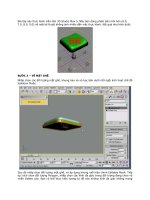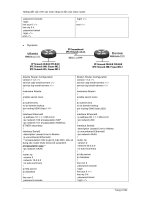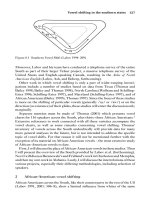the PCI Bus demystified phần 6 pdf
Bạn đang xem bản rút gọn của tài liệu. Xem và tải ngay bản đầy đủ của tài liệu tại đây (282.59 KB, 23 trang )
102
master can retain ownership of the bus. Typically, the lower three bits
are hardwired to 0 and only the upper 5 bits are writable. This yields
a maximum of 255 clock cycles with a granularity of eight clock
cycles. The Latency Timer may be read-only if the master never
bursts more than two data phases.
Cache-Line Size
Configuration software writes the system cache line size in
DWORD increments to this register. It is required for any master
that implements the Memory Write and Invalidate command and for
any target that implements cache-line wrap addressing. Masters that
implement the advanced read commands should take advantage of
this register to optimize their use of the read commands.
Cardbus CIS Pointer
Optional. Implemented by devices that share silicon between
cardbus and PCI devices. It points to the Card Information Structure
for the Cardbus implementation. Details of the CIS can be found in
revision 3.0 of the PC Card specification.
Capabilities Pointer
If Status Register bit 4 = 1, this read-only byte is a pointer to the
first entry of the Capabilities List. It is a byte offset into the device-
specific configuration space.
Max_Lat (Maximum Latency)
The specification says that this optional register specifies “how
often the device needs to gain access to the PCI bus”. A better inter-
pretation might be how quickly the master needs access to the bus.
Values of Max_Lat are in increments of 250 ns which happens to be
about eight clocks at 33 MHz.
PCI Bus Demystified
103
The intention is that configuration software can use this value
to assign the master to an arbitration priority level. Devices with
lower values, implying a need for low latency, would be assigned to
the higher priority levels.
Min_Gnt (Minimum Grant)
This register indicates how long the master would like to retain
bus ownership when it initiates a transaction. Values of Min_Gnt are
in increments of 250 ns or eight clocks at 33 MHz.
Configuration software uses this value to set the device’s Latency
Timer.
Base Address Registers (BAR)
The Base Address Registers provide the mechanism that allows
configuration software to determine the memory and I/O resources
that a device requires. Once the system topology is determined,
configuration software maps all devices into a set of reasonable,
non-conflicting address ranges and writes the corresponding starting
addresses into the Base Address Registers. The Type 0 configuration
header supports up to six Base Address Registers, allowing a device
to have up to six independent address ranges.
There are two formats for the Base Register as shown in Figure
6-7. Read-only bit 0 determines whether the Base Address Register
represents memory or I/O space.
For memory space, read-only bits 1 and 2 indicate how the
memory space must be mapped and the size of the Base Address
Register. Memory can be mapped into either 32-bit or 64-bit address
space implying respectively a 32-bit register or a 64-bit register.
A 64-bit register occupies two adjacent BAR locations in the
Configuration Header. Prior to revision 2.2 the combination 01
Plug and Play Configuration
104
in bits 2 and 1 identified memory space that must be located below
the one megabyte real mode boundary. Although this is no longer
supported, “System software should recognize this encoding and
handle appropriately.” Bit 3 identifies prefetchable memory.
PCI Bus Demystified
Figure 6-7: Base Address Register.
For I/O space, bit 1 is hardwired to 0 and the remaining bits are
used to map the device. An I/O Base Address Register is always 32 bits.
Determining Block Size
How does configuration software determine the size of the memory
or I/O space represented by each BAR? A Base Address Register only
implements as many bits as are necessary to decode the block size that
it represents. Thus, for example, a BAR that represents 1 Megabyte of
memory space would only need to implement the upper 12 bits of the
4 3 2 1 031
0
Base Address
Prefetchable
Type
00 - locate anywhere in 32-bit space
01 - reserved
10 - locate anywhere in 64-bit space
11 - reserved
Memory space indicator
2 1 0
31
1
Base Address
Reserved
I/O space indicator
105
32 bit address. The lower 20 bits decode an address within the 1
Megabyte range. When you read a BAR, the undecoded bits read
back as 0.
So the procedure for determining block size is to:
Plug and Play Configuration
Step 1 MB Example
1. Write all 1’s to the register 0xFFFFFFFF
2. Read it back 0xFFF00008
3. Mask off the lower four read-only bits 0xFFF00000
4. Take the 1’s complement 0x000FFFFF
5. Add 1. This is the block size. 0x00100000
The same procedure applies to I/O space and 64-bit memory space.
This strategy has two interesting consequences. Block sizes are
always powers of 2 and the base address is always “naturally aligned.”
This means, for example, that a 2 MB address space can’t have a
starting address of 3 MB.
Note that the minimum block size inferred by the Memory BAR
format is 16 bytes. Likewise the minimum I/O block size is four bytes.
In the interest of minimizing the number of bits in a BAR, devices
are allowed to consume more space than they actually use. The
specification suggests that decoding down to 4 KB of memory space
is appropriate for devices that need less than that. A device that
decodes more space than it uses need not respond to the unused
space. Devices that map into I/O space must not use more than
256 bytes per Base Address Register.
Use Memory Space if Possible
Although PCI fully supports “I/O” space, the specification recom-
mends that device registers be mapped into memory space if at all
106
possible. There are several reasons for this. In the PC architecture I/O
space is limited and highly fragmented making it potentially difficult
to allocate I/O space. Secondly, I/O space is assumed to have read
side effects and is thus not prefetchable. This precludes certain opti-
mizations that PCI-to-PCI bridges are allowed to perform. Finally,
some processor architectures simply don’t support the notion of I/O
address space.
In practice, some devices use two Base Address Registers to repre-
sent the same set of device registers. One of these BARs maps into
memory space, the other into I/O space. Configuration software will
allocate space to both registers if possible. Later when the device’s
driver is invoked, it will decide, based on its environment and other
considerations, which space to use.
What is “Prefetchable”?
Fundamentally, prefetchable memory space has no read “side
effects.” This in turn means that the act of reading a memory location
does not in any way change the contents. No matter how many times
you read it, you get the same result. Conventional memory is pre-
fetchable. A FIFO is not. Each time you read a FIFO you get the
next data element.
The primary objective in defining prefetchable memory is to
allow PCI bridges to prefetch read data. In many cases prefetching
can substantially reduce read latency. Consider a master agent exe-
cuting a read to a location on the other side of a bridge. If the bridge
recognizes that the location is prefetchable, it can go ahead and read
subsequent locations (prefetch) on the assumption that the master
intends to read further. If, on the other hand, the master chooses not
to read further, no harm is done because the prefetch has not altered
the contents of the prefetched registers.
PCI Bus Demystified
107
A further requirement on PCI prefetchable memory is that it must
return all four bytes on a read independent of the BE# signals.
Back in the days when processor cycles were at a premium, clever
hardware designers would build I/O registers with read side effects as a
way to simplify device programming. For example, the act of reading
a status register could clear the interrupt flag if it were set. This would
eliminate the need to write a zero back to that bit.
Today, trying to save a couple of instructions by using a non-
prefetchable register might actually slow the system down by
precluding other optimization strategies. Good design practice
emphasizes avoiding read side effects unless there is no alternative.
Expansion ROM
The Expansion ROM Base Address register operates similarly to
the Base Address registers just described. Since the expansion ROM
is assumed to exist in memory space, bit 0 is used as a ROM enable.
Bits 1 to 10 are reserved and bits 11 to 31 set the base address. The
ROM’s block size is determined in the same way as for other address
ranges with a granularity of 2k. The Expansion ROM Base Address
register is limited to 32 bits. See Figure 6-8.
The expansion ROM itself is organized as one or more “images”
with a specific format based on existing ROM headers for ISA,
EISA and Microchannel adapters. One major difference between
PCI expansion ROMs and previous implementations is that ROM
code is never executed in place. It must first be copied to RAM.
There are two reasons for this: RAM is generally faster than ROM
and the initialization code can be discarded after it is executed.
Just because a device implements an Expansion ROM Base
Address register doesn’t necessarily mean a ROM is present.
Plug and Play Configuration
108
Configuration software must test for the presence of a ROM by
testing for the ROM signature in the first two bytes of the header.
See Figure 6-9.
PCI Bus Demystified
Figure 6-8: Expansion ROM Base Address Register.
Figure 6-9: ROM image header.
1 0
31
Base Address
11 10
Address decode enable
Reserved
Image 0
Image 1
Image n
Header
Data Structure
Runtime
Code
Init
Code
Unused
Checksum
Checksum
15
0
AAh
55h
Init Size
JMP
offset to init code
00h
02h
04h
06h
Points to PCI data structure
Application
Specific
Data
16h
18h
Processor
specific data
109
Plug and Play Configuration
The next 24 bytes (16h) of the header are processor specific. For
x86 implementations, byte 2 is the length in 512 byte chunks of the
initialization code and the next three bytes are a short jump to the
init code. The POST code executes a far call to this location. The
remainder of the processor-specific field is available to the application
for various identifying information.
Finally, the last two bytes of the header are a pointer to a PCI data
structure. The reference point for this pointer is the beginning of the
ROM image.
Figure 6-10 shows the PCI Data Structure that provides addi-
tional information about the ROM image. The first four bytes are the
text string “PCIR”, a signature that verifies the existence of the data
structure. The vendor ID, device ID and class code fields must match
the corresponding fields in the device’s configuration header for the
image to be considered valid. Think of this as a “sanity check” to be
sure the right ROM is installed.
Figure 6-10: PCI data structure.
110
PCI Struct Len: The length of the PCI data structure itself,
currently 24 (18h) bytes.
Struct Rev: Revision level of the data structure. This is 0 for
Rev. 2.2 of the specification.
Image Length: Entire length of this image in 512 byte increments.
Code Rev: Revision level of the contents of this image. Assigned
by vendor.
Code Type: Identifies the type of executable code in the image,
either native machine language for a particular processor or inter-
pretive code conforming to the Open Firmware standard (IEEE
1275-1994). 0 = Intel x86 code, 1 = interpretive code, 2 = Hewlett-
Packard PA RISC and the values from 3 through FFh are reserved.
Capabilities List
Figure 6-11 shows the Capabilities List, a new mechanism in
Rev. 2.2 that supports new and optional PCI capabilities in the form
of an open-ended linked list. If bit 4 of the Status Register is 1, then
the byte at offset 34h in the header contains the offset to the first
element of a linked list of capabilities. The Capabilities List resides
in the device-specific portion of a function’s configuration space.
Each capability consists of an 8-bit ID code assigned by the PCI
SIG, an 8-bit offset to the next element in the list and some number
of additional bytes that may be either read-only or read/writable.
The offset field of the last capability in the list is set to 0.
The following capabilities are currently defined:
0. Reserved
1. PCI Power Management Interface, documented in the PCI Power
Management Interface Specification.
PCI Bus Demystified
111
2. AGP. Identifies a graphics controller using the features of the
Accelerated Graphics Port.
3. VPD. Provides support for Vital Product Data (see next section).
4. Slot Identification. Identifies a bridge that provides external
expansion capabilities.
5. Message Signaled Interrupts.
6. Compact PCI Hot Swap CSR.
Vital Product Data
Vital Product Data (VPD) is additional information that uniquely
identifies items such as hardware, software and microcode elements
of the system. Among other things, it can provide the system with
information on FRUs (Field Replaceable Unit) such as part number,
serial number, Engineering Change level and so on. VPD also provides a
mechanism for storing information about performance and failure data.
Plug and Play Configuration
Figure 6-11: Capabilities List.
112
Prior to Rev. 2.2, VPD resided in the ROM space accessed by the
Expansion ROM BAR. VPD now resides in an unspecified storage
device such as serial EEPROM on a PCI device. The storage device
is then read and written through the VPD capability shown in Figure
6-12. To read an element of VPD, you write its address into the VPD
Address field setting the flag bit, “F”, to 0. When the device has read
the specified four bytes from storage and placed them into the VPD
Data field it sets F to 1. To write a VPD field, you first write the data
to the VPD Data field, then write the address to the VPD Address
field setting F to 1. After the device has written the data to storage it
sets F to 0.
PCI Bus Demystified
Figure 6-12: VPD capability.
VPD is organized as lists of information fields as shown in Figure
6-13. The information field has a 3-byte header followed by some
amount of data as indicated by the length entry in the header. There
are two categories of VPD keywords: read-only fields and read/write
fields. The defined keywords are all ASCII and it is expected that the
data will be ASCII as well. Here is an example of the “expansion
board serial number” VPD.
Keyword: SN
Length: 8
Data: “01734672”
113
The information fields are contained within tagged data structures
consisting of large and small resource descriptors as shown in Figure
6-14. The format is described in Plug and Play ISA Specification,
Version 1.0a. Specifically, VPD uses four tag types as follows:
Plug and Play Configuration
Figure 6-13: VPD information field.
Tag Type
Resource
Description
Type
Identifier String
Large
First item in the VPD list. Contains
Tag (0x2) the name of the board in ASCII.
VPD-R Tag (0x10) Large List of read-only VPD fields.
VPD-W Tag (0x11) Large List of read/write VPD fields.
End Tag (0xf) Small
Identifies end of VPD data. The
End Tag has a zero data length.
Vital Product Data consists of one each of the above resource
descriptors in the order shown.
The read-only fields include:
PN Board Part Number. An extension of the Device ID
(Subsystem ID) in the Configuration Header.
EC EC Level. Identifies the Engineering Change Level of
the board.
114
MN Manufacturer ID. An extension of the Vendor ID
(Subsystem Vendor ID) in the Configuration Header.
SN Serial Number. Identifies a board’s unique serial number.
Vx Vendor Specific. Permits a vendor to create his own fields.
The second character (x) may be 0 to Z
CP Extended Capability. Allows a new capability to be identi-
fied in the VPD area. The data field is four bytes of
binary pointing to the control/status registers for the
capability.
Byte 0: Capability ID
Byte 1: Index of Base Address Register that contains
the capabilities CSR
Bytes 2 and 3: Offset from BAR to CSR
RV Checksum and Reserved. First data byte is a checksum from
the Identifier String Tag up to and including this byte.
Sum of all bytes must add up to zero. The remainder is
reserved space as needed to fill up the read-only space.
This field is required.
PCI Bus Demystified
Figure 6-14: Resource data tags.
115
The read/write fields include:
Vx Vendor Specific. Permits a vendor to create his own fields.
The second character (x) may be 0 to Z.
Yx System Specific. The second character of the keyword can
be 0 to 9 or B to Z.
1
YA Asset Tag Identifier. Contains an asset identifier provided
by the system owner. Primarily of interest to the bean
counters.
RW Remaining Read/Write Area. Fills up the unused portion
of the read/write space.
2
Summary
PCI supports Plug and Play configuration that allows a system to
be automatically configured at boot time. Each PCI function has 256
bytes of Configuration Space of which the first 64 bytes constitute a
pre-defined header that provides all of the functionality required to
configure the function.
Configuration Space also includes support for an expansion
ROM that can provide device initialization and BIOS extensions.
The Capabilities List provides an open-ended way to identify new
and optional PCI features. Vital Product Data is an optional feature
that offers additional information about a specific PCI device.
Plug and Play Configuration
1
It’s not clear from the specification who gets to assign these keywords.
2
The specification goes on to say “One or more of the Vx, Yx and RW items are
required.” I take this to mean that unless one of these items is present, there’s
no point in having a read/write section.The read/write section doesn’t include a
checksum.
116
It is entirely possible for device drivers to access the Configuration
Space directly using the mechanism described in the last chapter.
However, any software that does so is platform-dependent and may
not run on some platforms. This violates the spirit of PCI, which is
intended to be platform-independent. To solve this problem, the PCI
BIOS defines a platform-independent API to access configuration
features.
Operating Modes
x86 processors can operate in any of four modes:
■ Real Mode. The original 8088, 1 Mbyte address space
■ 16-bit Protected Mode. The 80286, 16 Mbyte address space
■ 32-bit Protected Mode. The 80386 and above, 4 Gbyte
address space, protected segments
■ Flat Protected Mode. Same as 32-bit Protected Mode except
everything is in one “flat” 4 Gbyte address space.
The PCI BIOS functions must be accessible from any of these
operating modes. Real mode and 16-bit protected mode use the
conventional INT mechanism that all traditional BIOS functions use.
PCI BIOS
C H A P T E R
7
117
32-bit and flat protected modes require a far call to an entry point
obtained from the BIOS32 Service Directory.
The PCI BIOS functions use x86 CPU registers to pass arguments
and return status.
Is the BIOS There?
The PCI BIOS is based on the Standard BIOS 32-bit Service
Directory Proposal put forward by Phoenix Technologies Ltd. Before
we can use the PCI BIOS, we have to determine if it’s present. In
real or 16-bit protected mode we can simply invoke INT 1Ah with
the appropriate function code and see what comes back. In 32-bit
protected mode we have to get the entry point from the BIOS32
Service Directory and so the first step is to determine if it exists.
The BIOS32 Service Directory is identified by the data structure
shown in Figure 7-1. The strategy is to scan the address range from
0xE0000 to 0xFFFFF looking for the signature “_32_”. If the signature
is found, the Service Directory can be accessed by calling the speci-
fied entry point.
PCI BIOS
Figure 7-1: BIOS32 Service Directory.
31
0
“_32_”
Entry point, 32-bit physical addr.
Rev
Level
Length
Check-
sum
Reserved
00h
04h
08h
0ch
118
Having found the BIOS32 Service Directory, we can now inquire
if the PCI BIOS is present. We call the Service Directory entry point
passing in a 4-byte service identifier string. If the service is present,
the Service Directory returns the base address, length and entry point
of the code image for the service.
BIOS Services
The functions making up the PCI BIOS fall into a few categories:
Identifying PCI Resources
PCI BIOS Present
Find PCI Device
Find PCI Class Code
Accessing PCI Configuration Space
Read/Write byte/word/dword
PCI Support Functions
Generate Special Cycle
Get IRQ Routing Options
Set PCI IRQ
PCI Bus Demystified
ENTRY:
EAX Service identifier. 4-character string
“$PCI” (049435024h)
EBX Function code in BL. 0 is the only function
currently defined. Other bytes 0
EXIT:
AL Return code
0 = service present
80h = service not present
81h = bad functIon code
EBX Base address of service
ECX Length of service
EDX Entry point
119
PCI BIOS
1 05 4
2 1 2 1
Config mechanism
Special cycle support
ENTRY
AX B101h
EXIT
CF 1 = no BIOS present
0 = BIOS present IFF EDX set properly
EDX “PCI “
CL Number of last PCI bus in system
BX Interface version: BH - major, BL - minor
AH Present status: 0 = BIOS present IFF EDX
set properly
AL Hardware mechanism
PCI BIOS Present
This is the way to determine if the PCI BIOS is present in real
mode. Even though we already know the PCI BIOS is present in
32-bit protected mode, this function returns some additional neces-
sary information. AL returns information about which configuration
and special cycle mechanisms are supported. CL returns the number
of the last PCI bus segment in the system. Segments are numbered
sequentially from 0 to the value returned in CL.
Find PCI Device/Class
This pair of functions allows us to locate PCI devices either by
class code or specific vendor and device ID. The first time either of
these functions is called, SI is set to 0. Then before each subsequent
call, SI is incremented. The function is called repeatedly until it
120
returns DEVICE_NOT_FOUND. The returned values are the location
in Configuration Space of the specified device.
ENTRY
AX B1 [02h | 03h]
CX Device ID (find device)
ECX Class code (find class)
DX Vendor ID (find device only)
SI Index (0 n)
EXIT
CF 1 = error, 0 success
BH Bus number
BL Device number (upper 5 bits)
Function number (lower 3 bits)
AH Return code
SUCCESSFUL
DEVICE_NOT_FOUND
BAD_VENDOR_ID (find device only)
Generate Special Cycle
This function generates a Special Cycle on the specified bus. Note
however that Configuration Mechanism 2 can only generate special
cycles on Bus 0 and will return FUNCTION_NOT_SUPPORTED if
you specify a non-zero bus number.
ENTRY
AX B106h
BH Bus number
EDX Special cycle data
EXIT
CF 1 = error, 0 success
AH Return code
SUCCESSFUL
FUNCTION_NOT_SUPPORTED
PCI Bus Demystified
121
Read Configuration Register (Byte, Word, Dword)
This set of functions allows you to read Configuration Space by
specifying the bus, device, function and register numbers. The service
will return the value BAD_REGISTER_NUMBER if the register
number is not properly aligned for the data size being requested.
Write Configuration Register (Byte, Word, Dword)
This set of functions allows you to write Configuration Space by
specifying the bus, device, function and register numbers and the data to
write. The service will return the value BAD_REGISTER_NUMBER
if the register number is not properly aligned for the data size being
requested.
PCI BIOS
ENTRY
AX B1 [08h | 09h | 0Ah]
BH Bus number
BL Device number (upper 5 bits)
Function number (lower 3 bits)
DI Register number
EXIT
CF 1 = error, 0 success
CL, CX, ECX Returned data
AH Return code
SUCCESSFUL
BAD_REGISTER_NUMBER
ENTRY
AX B1 [0Bh | 0Ch | 0Dh]
BH Bus number
BL Device number (upper 5 bits)
Function number (lower 3 bits)
CL, CX, ECX Data to write
DI Register number
EXIT
CF 1 = error, 0 success
AH Return code
SUCCESSFUL
BAD_REGISTER_NUMBER
122
Get Interrupt Routing Options
This function is used to determine what options are available for
routing INTx# lines to IRQs. The argument passed to this function is a
pointer to a data structure.
PCI Bus Demystified
ENTRY
AX B10Eh
BX 0000h
DS Segment or selector for BIOS data. Must
resolve to 0F0000h
ES Segment or selector of data structure
DI, EDI Offset to data structure
EXIT
CF 1 = error, 0 success
AH Return code
SUCCESSFUL
FUNCTION_NOT_SUPPORTED
BUFFER_TOO_SMALL
BX Bitmap of IRQs exclusively dedicated to
PCI devices
The structure pointed to by ES:DI(EDI) contains two fields: a far
pointer to a buffer to contain the returned interrupt routing informa-
tion and the length of that buffer represented in two bytes. A far
pointer is four bytes in real and 16-bit protected modes and six bytes
in 32-bit protected mode. The Get PCI Interrupt Routing function
will return an error if the buffer size is insufficient to store an Inter-
rupt Routing Table Entry for each device that requires an interrupt.
The buffer returned by the Get PCI Interrupt Routing Options
function contains an Interrupt Routing Table Entry for each PCI device
that requires interrupt support. See Figure 7-2. After identifying the
bus number and device number, an Interrupt Routing Table Entry
supplies two values for each of the four PCI bus interrupt lines. The
IRQ bit map values show which of the processor IRQs the interrupt
pin may be connected to. Bit 0 corresponds to IRQ 0 and so on.
123
The link value fields show which interrupt pins are wire-ORed
together. Interrupt pins that are wired together have the same link
value. The value is arbitrary except that the value zero means that
the interrupt pin is not connected to the interrupt controller.
Slot number indicates whether this table entry is for a mother-
board device or an add-in slot. A value of 0 indicates a motherboard
device, a non-zero value is a slot. This provides a way to correlate
PCI device numbers with physical slots. Assignment of slot numbers
is implementation dependent. The spec does recommend however
that slots should be “clearly labeled.”
Upon successful return, the buffer length field is updated to reflect
the actual length of the Interrupt Routing Table.
Set PCI Interrupt
Finally, having determined what possible routings exist, we can
establish a binding between an interrupt pin on a specific connector
and an IRQ at the processor. This function is intended to be used by
Figure 7-2: Interrupt routing table entry.
PCI BIOS
0 byte PCI bus number
1 byte PCI device number
2 byte Link value for INTA#
3 word IRQ bit map for INTA#
5 byte Link value for INTB#
6 word IRQ bit map for INTB#
8 byte Link value for INTC#
9 word IRQ bit map for INTC#
11 byte Link value for INTD#
12 word IRQ bit map for INTD#
14 byte Slot number
15 byte Reserved
Offset Size Description
124
PCI Bus Demystified
ENTRY
AX B10Fh
BH Bus Number
BL Device (high 5 bits), Function (low 3 bits)
CH IRQ. Valid values: 0 0Fh
CL Int Pin. Valid values: 0Ah 0Dh
DS Segment or selector for BIOS data. Must
resolve to 0F0000h
EXIT
CF 1 = error, 0 success
AH Return code
SUCCESSFUL
SET_FAILED
FUNCTION_NOT_SUPPORTED
Summary
The PCI BIOS provides a platform-independent means to access
Configuration Space. The BIOS is accessible from all operating
modes of the x86 processors. PCI BIOS services allow you to find
specific devices or device classes, read and write Configuration Space
and set interrupt options.
a system-wide configuration utility or a Plug and Play operating
system rather than by device drivers.









